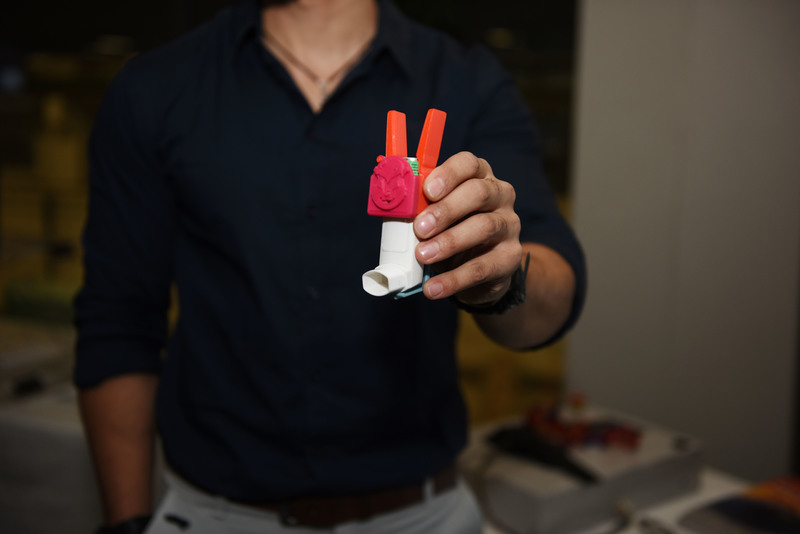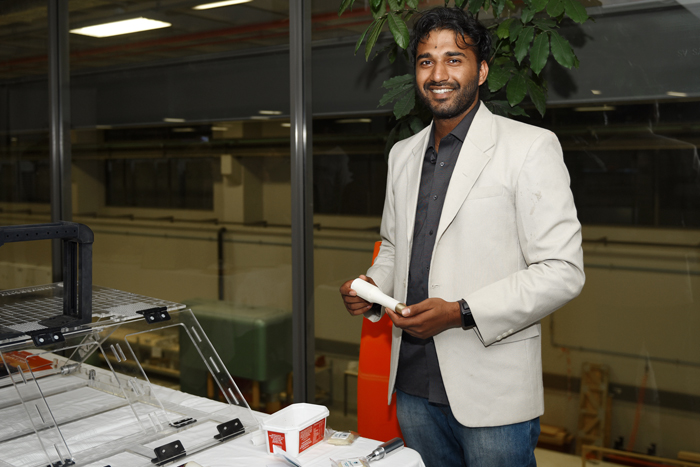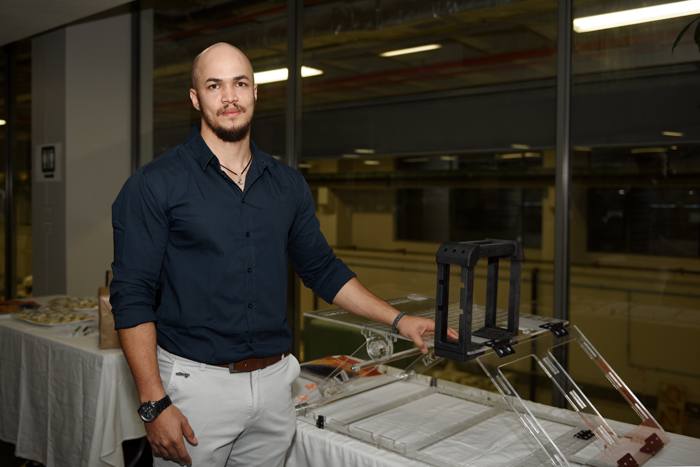Innovation improving lives
08 May 2017 | Story Kate-Lyn Moore. Photos Robyn Walker.
“We would like to create a culture of innovation.”
So said senior intellectual property officer Minah Moncho, of UCT's Research Contracts and Innovation office, as they presented a collection of inventions in celebration of World Intellectual Property (IP) day.
The office hopes to raise IP awareness and to teach students about the importance of patenting. It is their responsibility to ensure that all inventions born from publicly funded research are protected and commercialised, if possible, according to the Intellectual Property Rights from Publicly Financed Research and Development Act.
“This year's theme was innovation improving lives,” Moncho explained. “So here we are just showcasing some of the innovations that, in one way or another, sort of edify our lives, or have an impact on our lives.”
The majority of the inventions exhibited came from the division of biomedical engineering.
They were a small selection of the many innovative technologies and devices being invented by UCT researchers.
A paediatric metered dose inhaler
Children and elderly patients have difficulty activating standard inhalers, which require more force than they are able to muster.
Biomedical engineering master's student Giancarlo Beukes responded to this problem by developing a new and cost-effective device that can be activated with far less force.
He worked with senior lecturer Dr Sudesh Sivarasu, Associate Professor Dr Michael Levin, who heads up the Department of Paediatrics and Child Health, and fellow student Jason Voorneveld.
Their research showed that only children 12 years and up were able to activate standard inhalers, whereas children five and up were able to activate Beukes's new device.
“Because we are dealing with kids, you need to make it fun,” he explained. The device takes the form of a rabbit, with its ears forming a basic lever system. These are pushed together, which forces the medicine canister down and activates the inhaler.
The device is adjustable, to fit inhalers of different lengths. It also has an external dose counter.
“Imagine sending your kid on camp with an empty inhaler because you didn't know how much medication is remaining. So we needed to embed a dosage counter in our sleeve that doesn't affect the inner workings of the device.”
“The developing world is something that we focus on at UCT,” explained Beukes. “We develop for South Africa, in the African context.”
It was therefore imperative for the device to be available at a reasonable price, unlike other devices that also require little force to activate, such as dry powdered inhalers. These can cost between R800 and R3 000, he said.

An adrenaline auto-injector
An epinephrine injection is the safest known way of injecting adrenaline into the body following an allergic reaction, to prevent anaphylaxis.
“When [an allergic person gets] introduced to those antigens, their entire body kind of acts against them. Their immune system starts attacking them. Their central nervous system starts shutting down. They can't breathe and they need to get to hospital as soon as possible,” explained biomedical engineering master's student Gokul Nair. The epinephrine injection – is a lifesaving piece of technology.
But a single EpiPen® (the most popular brand currently on the market) could set you back R6 000, which is completely unaffordable for many South Africans. Moreover, the injector cannot be reloaded or refilled and expires every 12–18 months.
Nair, together with Sivarasu and Levin, responded to this issue by designing a reloadable auto-injector that costs a fraction of the price.
Patients push the device against their body and the needle auto-activates, much like the current injectors.
The development team discovered that if the adrenaline does not reach the correct depth in the muscle, it will not be absorbed quickly and correctly.
To prevent this from happening, the device has been designed so that the depth that the needle penetrates into the thigh muscle can be varied depending on the thickness of the fat layer of the person.
This means that a small child can use the same device as an adult.

A radiolucent laxity meter
Sivarasu worked with Dr Sarthak Patnaik (external) to develop a device able to measure non-invasively whether the ligaments in the knee joint have been ruptured.
It is far less expensive than those currently available.
“Once again, like I said, at UCT we focus on our environment, or our population. So we try and develop basic technologies that do the same job and that are affordable,” said Beukes, who contributed the final component to the device.
Its strength lies in its ability to measure the laxity of all four major ligaments. Existing devices are only able to assess the cruciate ligaments. It is also able to measure more than one angle of knee flexion, which will assist healthcare professionals with their diagnosis.
The device makes use of X-rays, as opposed to MRIs, to track the translation of the bone, which makes this a far more cost-effective device to use.
 This work is licensed under a Creative Commons Attribution-NoDerivatives 4.0 International License.
This work is licensed under a Creative Commons Attribution-NoDerivatives 4.0 International License.
Please view the republishing articles page for more information.










